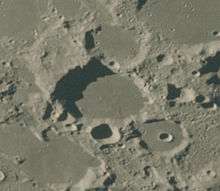Petrov (crater)
Petrov is an impact crater along the southeastern limb of the Moon. The crater is difficult to observe in this location, and visibility of this feature is affected by libration. The nearest crater of note is Chamberlin, just on the far side to the northeast. Somewhat farther to the west-southwest of Petrov is Gill.
 Lunar Orbiter 4 image | |
| Coordinates | 61.4°S 88.0°E |
|---|---|
| Diameter | 49 km |
| Depth | Unknown |
| Colongitude | 274° at sunrise |
| Eponym | Evgenij S. Petrov |

The rim of this crater has been worn and eroded by impacts, leaving an irregular ring of ridges and incisions along the inner wall. The smaller crater Petrov A intrudes slightly into the southern rim. Along the southeast, Petrov B is attached to the southeastern exterior and the two are joined by a narrow valley.
The interior floor of Petrov has been completely resurfaced by basaltic lava, leaving a low-albedo surface that is relatively smooth and featureless. This material is nearly as dark as the Mare Australe to the north. The floor is marked only by a few tiny craterlets.
Satellite craters
By convention these features are identified on lunar maps by placing the letter on the side of the crater midpoint that is closest to Petrov.
| Petrov | Latitude | Longitude | Diameter |
|---|---|---|---|
| A | 62.5° S | 88.3° E | 17 km |
| B | 62.3° S | 90.5° E | 31 km |
References
- Andersson, L. E.; Whitaker, E. A. (1982). NASA Catalogue of Lunar Nomenclature. NASA RP-1097.CS1 maint: ref=harv (link)
- Blue, Jennifer (July 25, 2007). "Gazetteer of Planetary Nomenclature". USGS. Retrieved 2007-08-05.CS1 maint: ref=harv (link)
- Bussey, B.; Spudis, P. (2004). The Clementine Atlas of the Moon. New York: Cambridge University Press. ISBN 978-0-521-81528-4.CS1 maint: ref=harv (link)
- Cocks, Elijah E.; Cocks, Josiah C. (1995). Who's Who on the Moon: A Biographical Dictionary of Lunar Nomenclature. Tudor Publishers. ISBN 978-0-936389-27-1.CS1 maint: ref=harv (link)
- McDowell, Jonathan (July 15, 2007). "Lunar Nomenclature". Jonathan's Space Report. Retrieved 2007-10-24.CS1 maint: ref=harv (link)
- Menzel, D. H.; Minnaert, M.; Levin, B.; Dollfus, A.; Bell, B. (1971). "Report on Lunar Nomenclature by the Working Group of Commission 17 of the IAU". Space Science Reviews. 12 (2): 136–186. Bibcode:1971SSRv...12..136M. doi:10.1007/BF00171763.CS1 maint: ref=harv (link)
- Moore, Patrick (2001). On the Moon. Sterling Publishing Co. ISBN 978-0-304-35469-6.CS1 maint: ref=harv (link)
- Price, Fred W. (1988). The Moon Observer's Handbook. Cambridge University Press. ISBN 978-0-521-33500-3.CS1 maint: ref=harv (link)
- Rükl, Antonín (1990). Atlas of the Moon. Kalmbach Books. ISBN 978-0-913135-17-4.CS1 maint: ref=harv (link)
- Webb, Rev. T. W. (1962). Celestial Objects for Common Telescopes (6th revised ed.). Dover. ISBN 978-0-486-20917-3.CS1 maint: ref=harv (link)
- Whitaker, Ewen A. (1999). Mapping and Naming the Moon. Cambridge University Press. ISBN 978-0-521-62248-6.CS1 maint: ref=harv (link)
- Wlasuk, Peter T. (2000). Observing the Moon. Springer. ISBN 978-1-85233-193-1.CS1 maint: ref=harv (link)